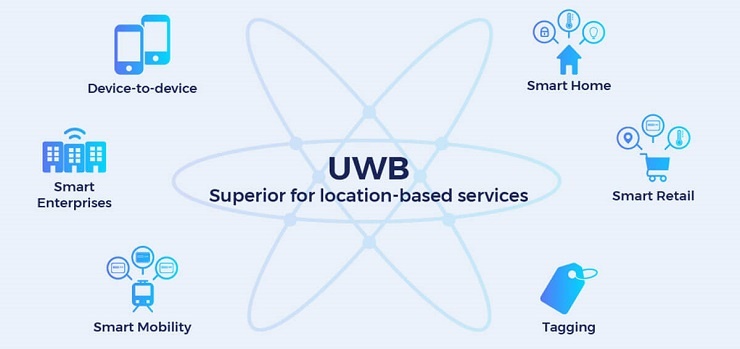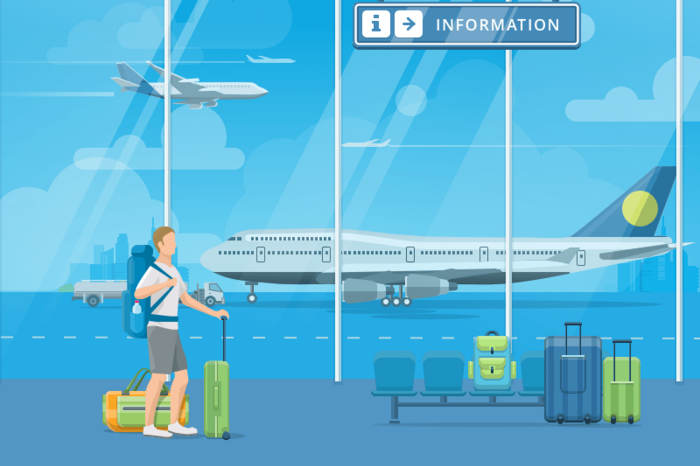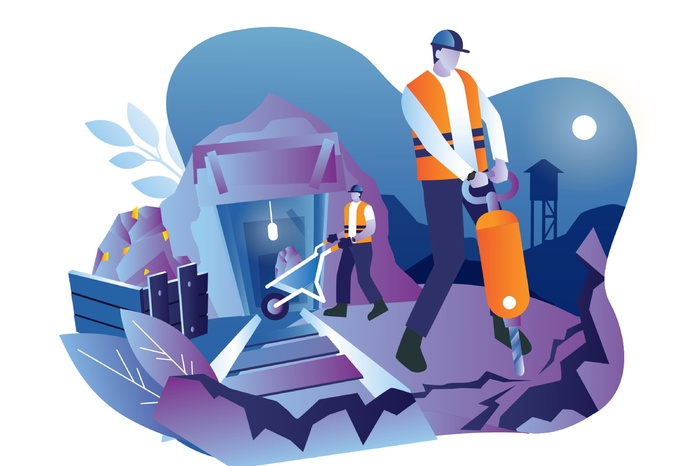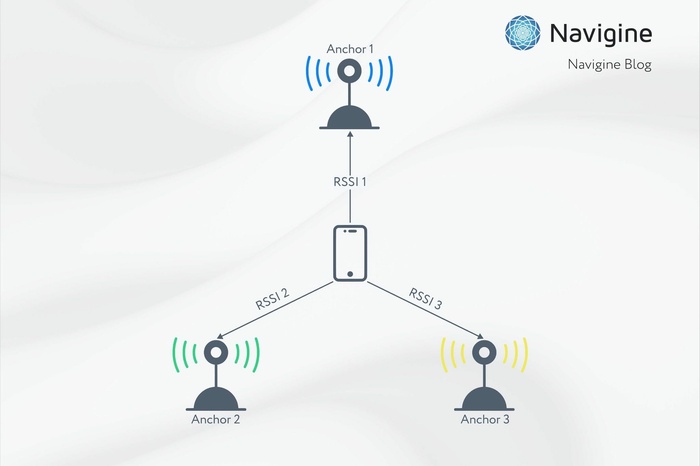The UWB indoor positioning system appeared more than 20 years ago but only recently it has spread to enterprises that require a standardized and unified wireless tool for connecting computer hardware. Using the UWB system, some really important tasks can be solved, including:
- reliable data protection;
- high-speed data transmission support;
- object localization;
- energy consumption reduction.
The Ultra Wide-band technology has potential. Thanks to high positioning accuracy, ranging from 10 to 30 cm, Ultra Wide-Band technology is widely used to control the perimeter of enterprise's dangerous places and control the implementation of KPIs at workplaces.
WHAT IS THE ULTRA WIDEBAND TECHNOLOGY?
UWB is an Ultra Wideband technology used for transmitting high-frequency impulses at small distances. UWB signals are transmitted at frequencies of up to some GHz and reach the bandwidth from 25% to 100%.
Computers and peripheral devices require a high-speed interface but using Bluetooth® and Standard 802.11 does not always help reach the set goals. The main disadvantage of such protocols is a small bandwidth (on average – up to 19 Mbits/sec), which is irrational for the applications that require high-rate transmission rates.
ULTRA WIDE-BAND TECHNICAL CHARACTERISTICS
UWB-signals are identified as any other signals with a spectrum width of more than 500 MHz and the range from 3.1 to 10.6 GHz. They are weak enough (41.5 dBm/ MHz). The implementation of the technology does not require compliance with the condition of straight visibility it is carried out using only some external elements. The UWB RTLS (real-time locating system) is an expensive technical solution ensuring the installation of UWB tracking devices (trackers) with the ability to determine the location up to 10cm.
HOW DOES UWB TRACKING AND POSITIONING WORKS?
While implementing UWB location tracking into the enterprise infrastructure, each tracked asset is equipped with a special tag with a built-in or attached accumulator. In its work, the tag takes billions of radio impulses that are emitted at an interval of a nanosecond in a wide-frequency range. Receivers, or transponders, detect these signals and turn them into information which makes it possible to define the object’s location.
Watch our webinar on "UWB Positioning and Its Industrial Applications: Noccela and Navigine Solutions":
What business tasks can UWB technology solve?
Ultra Wide-band is a protocol of wireless communication that makes use of electromagnetic emission at high frequencies. The technology is based on a wide bandwidth (500 MHz) that sometimes exceeds the minimal bandwidth for data transmission over short and long distances. This feature allows using UWB technology in geolocation systems and solving a wide range of tasks for increasing the efficiency of business processes.
Asset tracking for various spheres of activity
Companies can widely use UWB for tracking assets. Monitoring trolleys in stores, equipment at the production premises, and inventories are much easier with the help of UWB tracking. In sport the system makes it possible to track players on the field; in museums or exhibitions, it allows controlling the location of exhibits. This protocol can help to increase the safety of the enterprise, prevent thefts, and ensure the preservation of movable property.
Indoor navigation
UWB technology helps companies to increase the quality of service. After the implementation of the technology into the company infrastructure, users can get indoor navigation with the possibility to create interactive maps of the building in the mobile application. The Ultra Wideband positioning technology allows:
- Building routes to the points of interest.
- Locating quickly the necessary rooms, goods, and services.
- Sending notifications and tips based on the location.
- Providing useful content in real-time.
Monitoring the movement of visitors/ employees
The system allows the company to control the work of its employees and perform constant tracking of their activity: the time of coming to work, lateness, movements around the premises. Thanks to real-time tracking, the management can coordinate the employees’ actions and timely adjust daily tasks. Moreover, beacons can help to monitor visitor movements, analyze the traffic, and better understand clients’ behavior, which plays an important role in developing the marketing strategy.
Smart home
The UWB technology is an ideal tool for implementing the “smart home” system. The Ultra Wideband sensor constantly monitors the movements of visitors and makes the equipment perform certain actions, for example:
- Switch on\off the light in the room for energy saving.
- Regulate the volume of the speakers.
- Manage climate control.
- Maintain the ventilation mode.
- Activate the alarm system, etc.
Marketing and advertising opportunities for retail and shopping centers
While using Ultra-Wideband, shopping centers and shops can timely provide visitors with the relevant information on goods. The platform sends customers greetings, advertisements, notifications on sales, and promo actions. Thanks to this technology, stores get an additional marketing channel and can promote the brand or separate stock items more quickly.
Digitization of production and logistics enterprises
At the production enterprises, which specialize in producing goods, Ultra-Wideband can become an integral component of digitization in logistics and production. The system helps to digitize quickly and easily workshops, warehouses, technological processes, which contributes to increased productivity and business process optimization.
Social distance tracking
Due to the pandemic Covid-19, companies have to take measures for organizing social distancing. The UWB technology helps to solve this task effectively. As part of its implementation, the employees of the company are equipped with wearable devices that immediately inform about approaching another person. Thanks to this, it is possible to exclude too close contacts and minimize the risk of infecting the staff and visitors with the coronavirus.
Ways of location calculations for UWB positioning
While defining the location, the system uses very short signals traveling at the speed of light. Their arrival time is calculated in a wide bandwidth, so positioning accuracy can be from 10 to 30 sm. Depending on the needs of the company, UWB tracking can be used with such methods of calculation as AoA, TDoA, TWR, or PDoA.
TDoA
- Advantages: the most energy-efficient method
- Working principle: At the preset intervals the sensor emits signals received by the tags at different times (depending on the distance). The location of the sensor is calculated by the time difference between signals. TDoA is often called hyperbolic positioning. Since the method makes calculations by the time of signal arrival, it requires clear synchronization between the base stations.
- Sphere of application: computing the position of a great number of objects in real-time.
PDoA
- Advantages: can be used with the limited infrastructure
- Working principle: To define the location, the sensor evaluates the phase difference between the signals of receiving antennas. The impulse to the antenna located farther from the receiving device comes with a delay, which allows calculating the location of the tracked object. The signal angle is determined relative to the anchor point.
- Sphere of application: warehouses and other places with many assets.
TWR
- Advantages: positioning stability, high accuracy.
- Working principle: Tags send out short impulses that are detected by receivers. The distance is calculated by the time spent by the signals from the moment of sending to the moment of receiving. SDS-TWR is considered a more advanced method that applies double measurement successively in two different directions.
- Sphere of application: defining the location of equipment.
AoA
- Advantages: high accuracy within the limited infrastructure.
- Working principle: While using AoA, moving objects send out signals detected by tracking sensors. Receivers get these impulses and allow calculating the location by the Angle of Arrival and the direction regarding the tag. The signal level is also taken into account in calculating.
- Sphere of application: defining the location of objects in real-time.
Ultra wideband technology vs other technologies
UWB indoor positioning system does not concede to other radio-frequency technologies in terms of advantages and universality of application. However, the system has some considerable differences, the main one being in the level of accuracy of positioning and a wide frequency spectrum. High accuracy allows using UWB software in places where the real-time localization of objects may be of critical importance. Let’s consider other differences between ultra-wideband and Wi-Fi and iBeacon.
Wi-Fi
Wi-Fi is considered one of the most widely used radio-frequency technologies for defining object location. But it is still significantly inferior to UWB in terms of UWB accuracy. Ultra-wideband technology locates objects with an accuracy of up to 10-30 sm, while Wi-Fi gives results within the range of 3-5 m.
As opposed to Wi-Fi, UWB is not afraid of signal interference and possesses a high level of flexibility. It requires less energy, which reduces exploitation costs. However, the Wi-Fi-based platform can be realized using the existing infrastructure while the UWB implementation requires purchasing additional equipment.
A more detailed comparison of Wi-Fi and UWB is here: https://navigine.com/blog/uwb-vs-wifi/.
iBeacon
iBeacon and UWB have much in common. Both systems are characterized by low energy consumption, high accuracy, and reliability in tracking objects. But at the same time, they have some differences that should be considered while organizing RTLS. For example, iBeacon has a smaller range and speed of data transmission, while UWB is more precise in comparison with Bluetooth®.
As it was mentioned above, indoor positioning using UWB allows detecting objects with an accuracy of up to 30 sm, while iBeacon locates them within 1-5 m. The reason is that the ultra-wideband technology uses for calculation the ToF method that positions objects by the time of signal flight. Bluetooth® defines location using the RSSI method which carries calculations by distance and can’t ensure the necessary level of accuracy.
ADVANTAGES OF THE ULTRA WIDEBAND TECHNOLOGY
At present, Ultra Wide-band technology has high prospects for development. It is supposed to be widely used in the nearest future in the mass market and help in realizing many business solutions. It is caused by the variety of advantages that distinguishes this system from similar ones:
- absence of restrictions in HF-spectrum availability;
- noise immunity;
- possibility of simultaneous support of hundreds of channels;
- wide range of scalability by speed;
- simultaneous performance as a global, local and personal network;
- global compatibility of devices that use the radio-frequency spectrum;
- high data protection due to the signal power at the noise level;
- spectral flexibility;
- high-accuracy Ultra Wideband localization and object tracking;
- possibility of creating an individual communication network that will peacefully coexist with other Wi-Fi technologies in the office.
Technology has not only advantages but also some disadvantages. Because of the wideband and high power, Ultra Wide-band signals can impede already existing systems and communication lines. Ultra Wide Band technology differs in short signal duration. Such signals can be detected by a matched filter or autocorrelation device but in this situation, the reception can be difficult to synchronize.
SPHERES OF ULTRA WIDEBAND TECHNOLOGY APPLICATION
Every year Ultra Wide-band positioning is becoming more and more sought-after among business representatives. The technology used to be applied only at military sites, but now it is used in industry, healthcare, trading, culture, and logistics.
Retail and shopping centers
In trading, UWB ensures the transparency of goods and equipment location. It helps to organize convenient navigation around the store, build interactive maps with point-of-interest visualization, and carry out staff monitoring in real-time. Thanks to this system, retailers can easily improve staff performance and significantly increase customer loyalty to the given place.
Healthcare
Since UWB signals do not interact with each other and other radio frequency components, the technology can be successfully applied for creating noise-resistant solutions. Thus, in healthcare, it is used for tracking ventilators or X-ray equipment and for a quick search and localization of any other medical assets (RTLS hospital tracking), including wheelchairs or costly machines.
Logistics and warehousing
The implementation of the UWB system into the warehouse infrastructure allows managing business processes more effectively. It is of high priority in tracking goods, stock, or vehicles, especially in cases when it’s necessary to know the exact location of assets. Companies can use the transport and forklift tracking system, adjusting everyday tasks, which ensures effective business process optimization and helps to respond immediately to emergencies.
Industry
UWB tracking is widely used in the sphere of industry. Implemented into the factory infrastructure, the system performs several functions:
- building interactive maps with access zones;
- people and asset visualization on the map;
- tracking objects in real-time;
- creating optimal routes for vehicles;
- warning on a possible collision with a vehicle or an employee;
- equipment downtime control;
- tracking staff contacts for complying with regulatory requirements and increasing labor safety.
Transport
The system can become an effective solution in navigation and positioning on the territory of airports or railway stations. It helps passengers to create the maps of the transport hub, build routes to the points of interest, easily orientate on the field. Placing tags on the equipment lets the management control its movement, define the exact location of self-propelled passenger steps, haulers, and platform buses. Moreover, the technology ensures constant tracking of the flows of people and helps to avoid jams in crowded places.
Museums and events
Ultra Wideband positioning can be used in museums for creating an intellectual mobile guide. Tags, attached to the exhibits, help visitors quickly find the necessary expositions. While using the platform, there is a possibility to monitor the flows of people at exhibitions and various events. It helps to evaluate the success of the current event and undertake effective planning of new ones. Visitor tracking makes it possible to increase safety and security, timely detect ‘problem’ areas, and optimize the arrangement of exhibits taking into account people’s interests.
Countering the spread of Covid-19
In 2020 the technology proved to be effective in solving the tasks of social distancing and monitoring the spread of Covid-19. UWB system is used in wearable devices (watches, badges, etc.) that send notifications about the necessity to keep the distance if you come too close to another person. Also, the system allows tracking contacts and, in case of infecting a person, it can easily identify those who have contacted him.
Navigine is ready to assist in organizing UWB tracking at an enterprise. We develop efficient software products that allow solving a wide range of tasks in the sphere of indoor positioning and navigation based on localization.
Are you interested in UWB tracking and positioning? Discuss more in a private free consultation:




